총 44 개의 게시물이 있습니다.
-
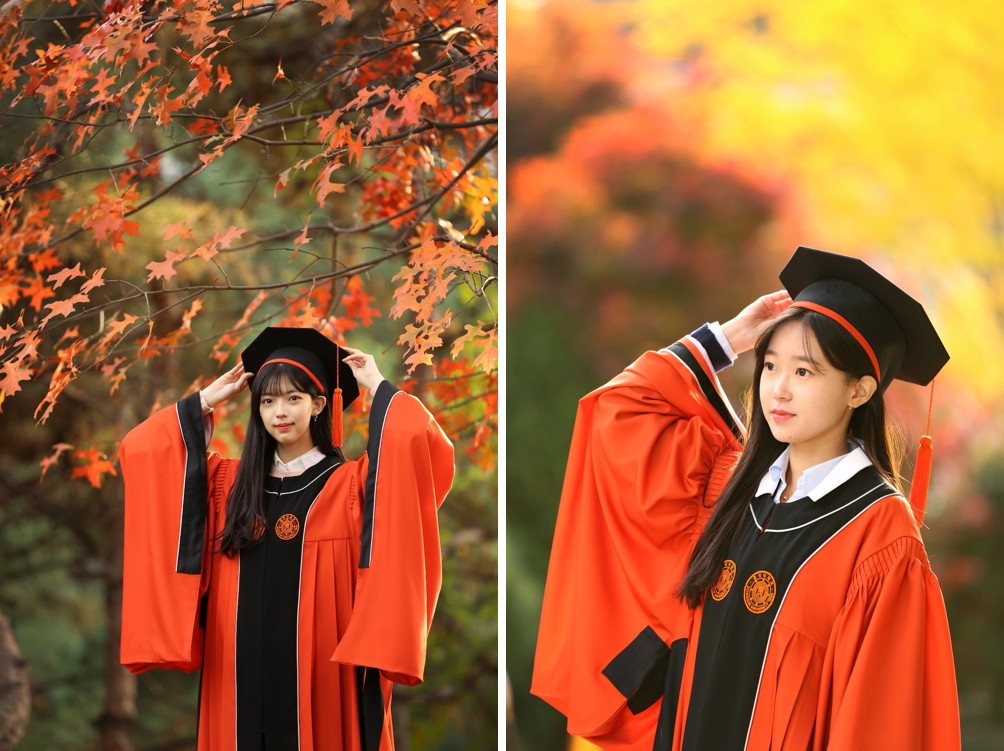
Dongguk University changes the design of its graduation gowns af...
Dongguk University changes the design of its graduation gowns after 115 years Designer Sang-bong Lee has designed the graduation gowns of Dongguk University in line with “Korean traditional beauty,” which will be worn during the 2022 spring commencement ceremony for the first time.The newly designed Dongguk University graduation gowns will be worn by its bachelor’s degree awardees.President Sung-yee Yoon of Dongguk University showcases the newly designed academic regalia, which has changed 115 years after the opening of the university in 1906.The existing graduation gowns are in the form of religious robes that were commonly used by universities across the country and have been criticized for not reflecting Dongguk University’s unique founding philosophy. As a response, Jung-seok Sung, the Chairman of Dongguk University’s academic regalia renewal committee, has worked on a renewal project by considering the opinions of several committee members suggesting that Dongguk University needs its own cap and gown.Sung-hwan Cho, head of Dongguk University’s Communication and Public Relations team, explained, “To revive our university’s identity and historical tradition based on Buddhist spirits, the logo and color are reflected in the unique design of Dongguk University. In particular, we focused on designs that would make the gowns look the most stylistic and beautiful when the students wear them.”Accordingly, the gowns were designed by Sang-bong Lee, a Korean fashion master designer. He analyzed and reinterpreted the features of traditional dresses, such as Hanbok and Buddhist Jangsam robes, and used collars, hemlines, sleeves, and folds as design elements to capture Korea’s traditional beauty in the graduation gowns.Designer Lee added slits and folds to the graduation gowns to depict lotus flowers, symbolizing Buddhism, and highlighted the number eight by adding eight folds and using an octagonal graduation cap. In addition, to preserve the aesthetics of the Korean apparel, the width of the sleeves was widened, and the collars were designed to face each other to accentuate the neckline. He added, “the fabric used by other universities is cut in a straight line, while for Dongguk University’s graduation gowns, the line is cut diagonally to makes their A-line look more stylistic. Additionally, the collars are detachable, which make it easier to wash them. To add practicality, pockets were added to make it easier to put ones’ hands into them, increasing their utility for active uses as opposed to the existing graduation gowns.”All graduation gowns to be worn by the bachelor’s, master’s, and doctorate degree awardees have Dongguk Orange as the main color, the signature color of the university. The backside was folded into several layers. The identity of the university was further strengthened by adding sleeve openings in the form of a letter D and a logo engraved on the chest to represent the unique features of Dongguk University. With the release of the new academic regalia, students are also showing enthusiasm on Internet communities.Dongguk University plans to use the newly designed graduation gowns from the spring commencement ceremony of 2022.
2022.01.12. 조회 6619 -
The 9th place in the 2021 JoongAng Ilbo College Evaluation is th...
The 9th place in the 2021 JoongAng Ilbo College Evaluation is the fruit of your sweat and toilDear beloved Dongguk family members!This morning, I felt an auspicious energy that no one knew existed when I saw this year's first snow falling from the sky. Perhaps it was the harbinger of what's to come on The JoongAng Ilbo University Ranking announcement.In the 2021 JoongAng Ilbo University Ranking, our university ranked ninth, the highest ever. This is a feat that all the Dongguk people wholeheartedly welcomed with concerted efforts under the motto of "Energize Dongguk."First and foremost, let us all share full-on congratulations and encouragement with each other. This is a proud achievement and also a brilliant accomplishment that we have made. This is all the more meaningful and joyful in that this result was made possible by not just some individuals but by all of us believing we are all in this together.A university is an organization where education, research, and administration are closely tied together. Behind the fact how Dongguk University, the complex organism, was able to enter the top-ten ranks for the first time in the history of the university ranking is because of the Dongguk members who are doing their parts, working hard to get things done in their respective positions. Thanks to the faculty members' endeavors for teaching and research and the staff members’ efforts on duties such as administrative work, today we were able to achieve the best performance ever.The JoongAng Ilbo reported, "Dongguk University (Seoul) had been below the top-20 in the overall ranking until 2010 and has remained at around 17th since 2010. However, in this year's assessment, it was included in the top-ten for the first time based upon the rise in the ranking in the research category and the strengths of its students' job landing and start-ups."While reading the news article, I reminded the time when I became the president first time. Our university was ranked 17th for four years in a row from 2016 to 2019. As I became president, I said I would aim for our university to be within the top-ten ranks in university evaluation, laying out the plan for the “Energize Dongguk” project.The responses around me were not all as favorable as I had hoped. Many responded that it was too difficult to come true. Some cautioned that though that would be practicable, it would take a long time. But I did not give up. I did not doubt myself. I had a strong belief and conviction. I steadfastly believed in the power of "Dongguk" and the power of "us." I had a confidence that we would surprise everyone.First, I laid the foundation. Going back to where it all began to realize the Dongguk University’s founding philosophy "Safeguard the nation through education” with a beginner’s mind, I focused on education itself, the base of a university. I built up a framework. To fulfill the responsibility of a university as a specialized research institute, I endeavored to bring some fundamental changes in turning Dongguk University into a research-oriented one through the "Energize Dongguk" project. Week after week with department chairs, I formulated and revised strategies over and over again.The synergies between education and research has returned the amazing results we have today. Some may say this was a "miracle" while reading news articles. Nevertheless, all including myself are fully aware. What they call a "miracle" are in reality the sweat we shed, the time we spent collecting thoughts sometimes agonizingly, and all the efforts we cannot stop making.Dear Dongguk family members!I hope you enjoy the result to your heart's content and have fun with no worries, and from tomorrow, let us once again take a step forward to a new goal. Dongguk University made this year the first year of the second phase of building our university, with the launch of the University Rebuilding Advisory Committee, which was kicked off in April. Now, we have to move beyond "Energy Dongguk" to "Globalize Dongguk."This would not be an easy road. This could be a difficult journey to overshadow the achievements we have made so far. However, let us not give up. Let us not doubt ourselves. If we trust each other and keep moving on, we will surprise the world again.Let us walk together toward a new goal. Believing that Buddha's mercy will always be with us in our future, I wrap this up. Thank you.November 10, 2021Palms together,Yoon Sung YeePresident, Dongguk University
2021.11.12. 조회 4990 -
Dongguk takes the 9th place in the university evaluation by Joon...
Dongguk takes the 9th place in the university evaluation by JoongAng Ilbo, the highest ranking everThanks to the implementation of the Energize Dongguk project and the founding philosophyDongguk stands out in the fields of research competitiveness and student job placement and start-ups, entering top-ten positions for the first time.Dongguk University (President Yoon Sung Yee) ranked ninth, the highest ever, with an eight-notch increase from the previous year (excluding 2019 and 2020) in the 2021 JoongAng Ilbo university ranking released on November 10.Dongguk University has made it to the top-ten ranks for the first time in history with an even rise in rankings in various fields, including 5th in the student education category (formerly 8th), 12th in professor research (previously 27th), 13th in reputation (previously 16th), and 26th in educational environment (previously 22nd).Dongguk University, which remained 17th for the last four years from 2016 to 2019, has been reborn as a research-oriented university through the "Energize Dongguk" project that began in 2019. Research competitiveness and the strengths in the fields of student job placement and start-ups were most conducive to bringing out such good results. Also highlighting this point, The JoongAng Ilbo reported, "Dongguk University (Seoul) had been below the top-20 in the overall ranking until 2010 and has remained at around 17th since 2010. However, in this year's assessment, it was included in the top ten for the first time based on the rise in the ranking of the research category and the strengths of its students' job landing and start-ups."The research category is such an influential category since the weight of the category in the JoongAng Ilbo university ranking accounts for 32%. Dongguk University's ranking in faculty members' research category rose 15 notches from before, which led to a rise in the overall ranking. The university ranked 12th in all sub-categories of research prowess, including 11th for citations in international journal papers; 27th for technology transfer fee revenue per science and technology professor; 14th for international journal papers per professor; and 26th for on-campus research expenses per professor. Universities that swiftly improved their research competitiveness in the science and engineering field ranked 1st to 10th, ranking at the top.Most remarkable in the JoongAng Ilbo university evaluation is found in the student education category. The student education category is related with universities' efforts to help their students advance into society, such as the quantity and quality of job placement or start-ups, on-the-job training, and start-up education. It is of particular note that The JoongAng Ilbo took into account not only the quantitative performance of student start-ups such as start-up subsidies and number of enterprises, but also qualitative aspects such as sales revenues per company, number of those employed, and persons who support start-ups.Dongguk University scored 54.78 points out of 80 points, ranking fifth. Hanyang University (Seoul) 62.74 points; Sungkyunkwan University 56.71 points; Yonsei University (Seoul) 56.56 points; and Korea University (Seoul) 56.00 points, ranking first to fourth, respectively. It also ranked high in the job placement rate category. With both the net and the employment retention rate being in the top ten, Dongguk University once again showcased that it is a university with excellence in both "quality and quantity" of employment. The net employment rate ranked 10th with 71.44%, and the employment retention rate ranked 8th with 89.70%.It was remarked by Yoon Sung Yee, the President of Dongguk University, upon hearing the results of the university evaluation that most important is to continue to focus on “education” itself, the base of a university by keeping the beginner’s mind to uphold the university’s foundational spirit “safeguard the nation with education.” Further to this, he mentioned that he endeavored to bring some fundamental changes in turning his university into a research-oriented one through the "Energize Dongguk" project, and that the synergies between education and research have produced these good outcomes. He also added that with the launch of the University Rebuilding Advisory Committee, which was kicked off in April 2021, this year would be the first year of the second phase of building the university, and that Dongguk University will keep pushing forward to move beyond “Energize Dongguk” toward “Globalize Dongguk."
2021.11.12. 조회 4594 -
Dongguk University held 2021 Summer Graduation Ceremony online a...
Dongguk University held 2021 Summer Graduation Ceremony online at 10 am on Aug. 19Dongguk University held the 2021 summer graduation ceremony at 10 am on August 19, 2021. The total number of degree recipients was 1,468, including 99 PhD’s, 215 master’s and 1,154 bachelors.In his graduation speech, President Yoon Sung Yee said, “You started college life offline but completed it online. Based on this experience, I encourage all of you to become smart leaders in the new contactless era. Instead of seeking immediate gains, you need to cherish everlasting values, and honesty, sincerity, and sacrifices as well as appreciation and thoughtful consideration will guide you toward success and prosperity.”Amid COVID-19, the graduation ceremony was pre-recorded. After editing, the completed video file was posted on the official YouTube account of Dongguk University.According to the released video, the ceremony proceeded in the order of opening remarks of the ceremony, the three Buddhist rites, report on academic affairs; president’s graduation address, chairman’s address, congratulatory speech by the president of the alumni association, video clips of congratulatory remarks by alumni, presentation of awards to graduates and persons of merit, graduation ceremony where the president grants the degree to individual graduates, singing the school song in unison, chanting of the Four Great Vows, and closing ceremony.Of these, the visit-and-grant graduation ceremony, which was first devised to meet the wishes of graduates who were not happy with a graduation ceremony online, drew keen attention. President Yoon and Deans of colleges visited the graduates in person to confer graduation certificates and graduation gowns and took pictures with them. The university selected five graduates via application. For two days from August 10 to 11, they visited in-person places designated by each graduate and presented them “a customized graduation ceremony.”In addition, the university will operate an outdoor photo zone for graduates until August 29. To create an atmosphere for graduation ceremony, the school installed back walls, photo booths, and Ako character balloons at Paljeongdo and Students’ Union in Seoul Campus.
2021.09.02. 조회 5307 -
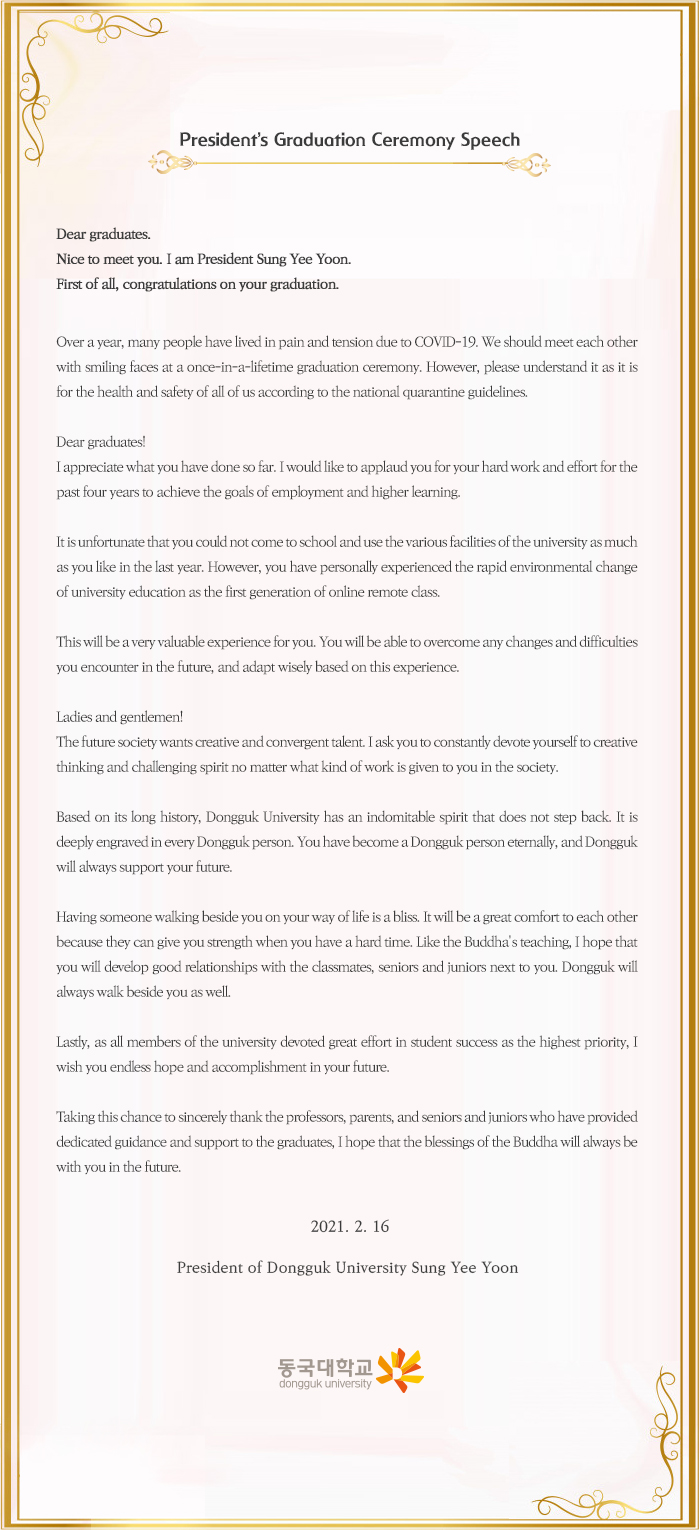
President’s Graduation Ceremony Speech
2021.02.16. 조회 5431 -

The honorary president of KCC, Chung Sang-yung, who donated KRW ...
The The honorary president of KCC, Chung Sang-yung, who donated KRW 14.5 billion for the development of his alma mater, has passed away Admitted to the Department of Law in 1955, he founded KCC in 1958 with the industrial patriotic spirit The founder and honorary president of KCC, Chung Sang-yung (admitted to the Department of Law in 1955) who donated KRW 14.5 billion for the development of his alma mater, Dongguk University, passed away in the evening of January 30th.Honorary president Chung Sang-yung, the youngest brother of the late Chung Ju-yung, the honorary president and the founder of Hyundai Group, was born in Tongcheon, Gangwon-do in 1936 and founded Keumkang Slate Industrial, KCC’s predecessor, at the age of 22 in August 1958. He rejected support from his oldest brother, the late Chung Ju-yung, and chose to become independent. He founded Korea Chemical in 1974 and entered the paint business, which is in the field of organic chemistry. In 1989, he separated the construction business division and established Geumgang Engineering and Construction (currently KCC E&C). After merging Geumgang and Korea Chemical, and launching Geumgang KCC in 2000, he changed the company name to “KCC” in 2005 and developed it into a global chemical company of advanced materials, ranging from construction to silicon and advanced materials.Honorary president Chung Sang-yung, who entered the Department of Law in 1955 and established a relationship with Dongguk University, donated KRW 14.5 billion to Dongguk University during his lifetime, significantly contributing to the development of the alma mater and the cultivation of younger students. This is the largest amount donated by an individual since the opening of the University. The donations were made for various areas, such as scholarships for national examination candidates, a school purchase fund, and a construction fund. In particular, KRW 11.8 billion worth of private materials were donated in 2014, and “Sangyung Bio Hall” was built on Goyang Campus of Dongguk University.At the time of donation, honorary president Chung Sang-yung, said, “I decided to donate in the hopes that my alma mater would perform better. I would be grateful if all the members of the school, alumni, and Buddhists could also contribute to the development of Dongguk University.” In response to his statement, many people, including Yeong-il-am monk Hyun-eung, made donations.At the completion ceremony of Sangyung Bio Hall held in November 2014, he stressed that “naming the building ‘Sangyung Bio Hall’ does not mean commemorating my name,” but “it means coexistence and co-prosperity of universities that study life sciences, life science industry, and of many people in our society.” President Yoon Sung-yee expressed gratitude and condolence, stating that “the honorary president, Chung Sang-yung, is a proud Dongguk man who contributed to national economic development as the first-generation Korean businessman” and “the great love that he has given to his alma mater Dongguk University for decades, for cultivation of talents will be forever remembered in the hearts of all Dongguk people.”
2021.02.15. 조회 5308 -
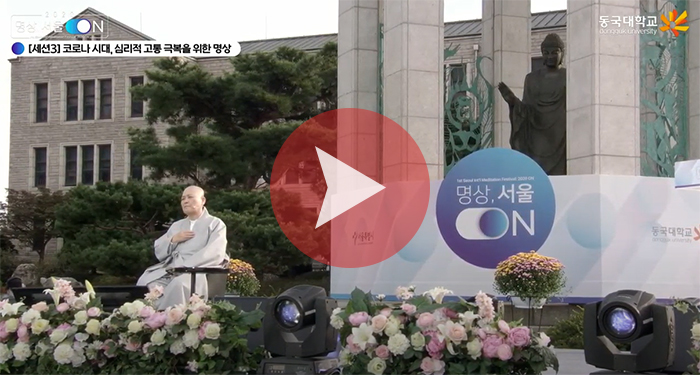
First Seoul International Meditation Festival Organized by Dongg...
First Seoul International Meditation Festival Organized by Dongguk University.Dongguk University hosted its first annual Seoul International Meditation Festival to overcome the COVID-19 crisis. Sponsored by the Seoul metropolitan government, the event’s theme was “Meditation, Seoul On.” The event focused on introducing various meditation techniques to overcome COVID-19 for those working tirelessly, such as medical staff, and those who are suffering from the disease, and it was accessible on websites such as YouTube. In the first part, a meditation talk concert on the theme “Us in the Coronavirus era” was held. In the second part, which began at 7 pm, a meditation music concert titled “The Coronavirus era, the time of warm melodies” was held. At the talk concert, Joan Halifax Roshi, head of the US-based Upaya Zen Center, Dr. Lee Dong-hwan, head of the Job Stress Institute, and Registered Nurses Park Wan-im and Lee Jung-hwa from Dongguk University’s Ilsan Hospital introduced the practice of meditation for those who are committed to overcoming COVID-19. Dr. Alan Wallace of Crestone Mountain Zen Center in Colorado, Professor Kim Hyun-soo, head of Seoul’s COVID-19 Psychology Support Group, and Son Eun-ju, Konkuk Middle School in Busan, delivered lectures on the topic “How to greet the new normal and meditate in the post-Corona era.”
2020.11.24. 조회 2247 -
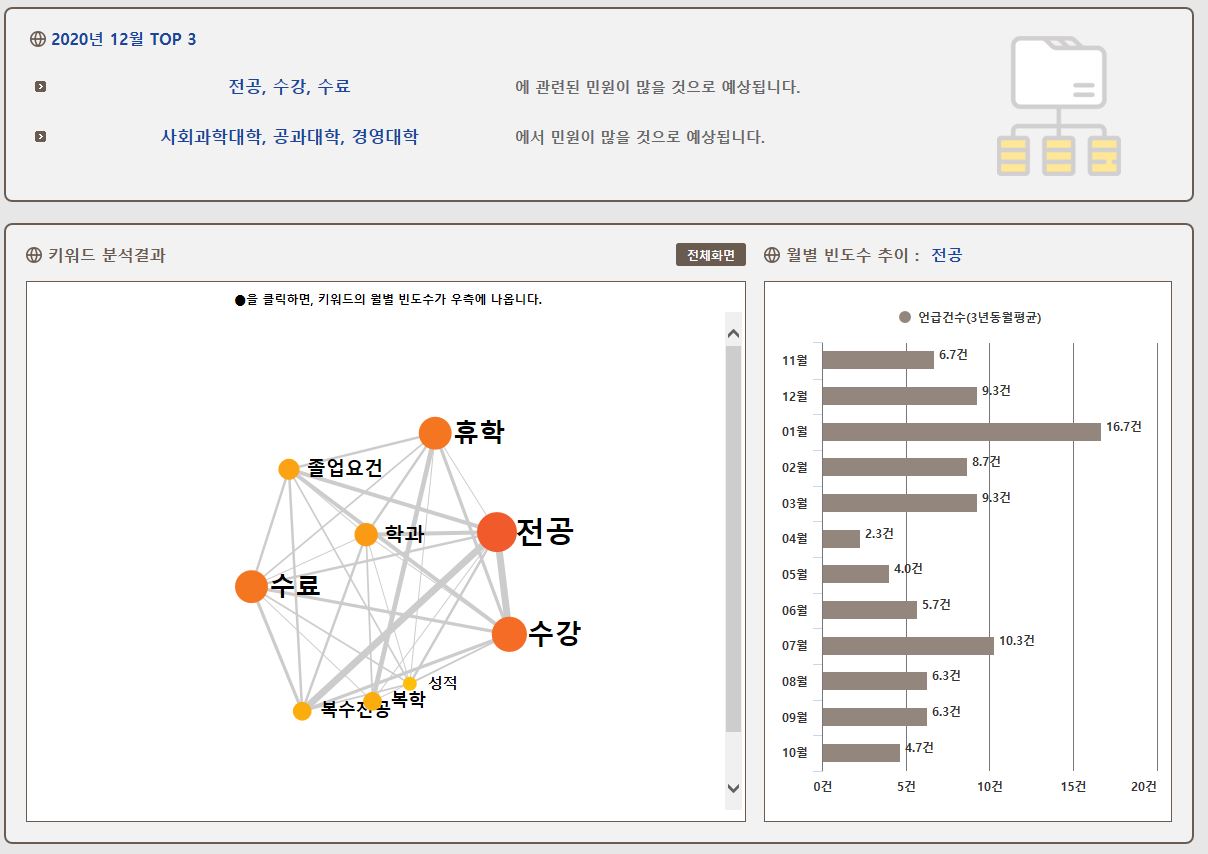
Student Complaints to be Predicted and Addressed using Big Data
Student Complaints to be Predicted and Addressed using Big DataDongguk University patents its data-based “decision-making support system”Dongguk University (President Yoon Sung-yee) has independently developed an IR (institutional research) system, the data-based “decision-making support system,” bringing the university into spotlight among the country's universities. The university has also completed the process of filing the patent of the system.Soon after the inauguration of President Yoon Sung-yee, Dongguk University spurred its efforts regarding the creation of an IR system and appointed a team dedicated to supporting the university's data-based decision-making. The development of the IR system commenced in March, 2020, and the project was completed in seven months in September, 2020. Following a prior art search with a view of registering the patent for the IR system, the patent filing process was completed on the 12th October, 2020. The services of the system were launched in the university after the filing of the patent. The IR system provides 13 services in the following three areas for the faculty and staff: management and administration, on- and off-campus evaluation, and teaching and research. The system has the following specialized functions: a) prediction of student complaints, b) prediction of dropout potential of students, c) analysis of Key Performance Indicators (KPIs), d) simulation of external evaluations including assessment of basic competencies of university students, and e) analysis of students' learning activity over the life cycle.The IR system functions related to administration divisions can predict probable on campus student complaints. For instance, the system has predicted that next month (December) will bring a lot of complaints from students belonging to the College of Engineering, College of the Social Science, and Dongguk Business School regarding their majors, enrollment, course completion, etc. This prediction is generated from the data accumulated over the last three years. The IR system will thus assist in enabling a systematic response by the university ahead of time based on the prediction of students’ complaints.Gong Hye-jeong, the manager of Dongguk University's IR team, said, "Although we are expected to ensure qualitative management of resources and upgrade the students’ qualitative competitiveness to cope with the rapidly changing higher education environment, many of the universities in the country have faced the problem of inefficient administration due to irrational decision-making that depends on intuition or personal experiences." Gong added, "As making strategic and reasonable decisions based on objective data and information can support higher competitiveness and sustainable growth of students, we have established the data-based decision-making system."With the establishment of its IR system, Dongguk University is now able to preemptively solve various on-campus problems and provide customized administrative services. The university expects that the system will improve the quality of education by creating an efficient data use and feedback system and also boost its management performance, leading to its excellent performance in the sectors of education and management.
2020.11.18. 조회 1775 -
2020 Dongguk International Virtual Winter School newly launched
2020 Dongguk International Virtual Winter School newly launchedDongguk University will be hosting its first Dongguk International Virtual Winter School.The COVID-19 pandemic has brought about a recession in global interaction and global education market growth. This has led to a significant decrease in the actual number of exchange students and has resulted in Dongguk International Summer School being cancelled, despite having been organized without fail for the past 13 years consecutively. Dongguk University will launch the "2020 Dongguk International Virtual Winter School," an online-based short-term special program, to overcome these limitations of physical mobility constraints. This virtual school intends to set forth a direction for international education programs in the COVID-19 era and seek a way to advance in the global education market, which has shrunk due to COVID-19.The Virtual Winter School will be held for about two weeks from December 23 to January 8 via the Webex tool, a remote video education system, with two English courses focusing on film and media, the representative academic fields of our university.The course of ‘Introduction to Korean Film’ will introduce the creative and commercial rebirth of 101 years of Korean cinema from the 1960’s until Director Bong Joon Ho’s Parasite winning the 2020 Oscar for Best Picture by which time the most transformative changes in Korean society had already taken shape. Through screening various Korean films of this era and discussing their representations of Korean culture, students will explore the tumultuous transformations of Korean society from the Korean War and military dictatorship to rapid capitalization and democratization. The course consists of lectures, film screenings, and discussions. ‘Korean Pop Culture ; Society & Media’ aims to introduce students to cultivate an appreciation of Korean film, TV drama and music as a complex form of popular culture. The class will also look more deeply at Korean society and the nature of popular culture itself, and the intertextual relationship of individual text & cultural industries with the audience.The 2020 Dongguk International Virtual Winter School will be open for students enrolled in our school as well as students from overseas universities interested in Korean pop culture and the latest media trends such as K-POP and K-movies. The participants will be offered a valuable opportunity to share their knowledge and thoughts with each other in the era of COVID-19.For more information about the Virtual Winter School, please refer to the link below.http://diss.dongguk.edu/bbs/board.php?bo_table=diss7_1
2020.09.29. 조회 2381 -
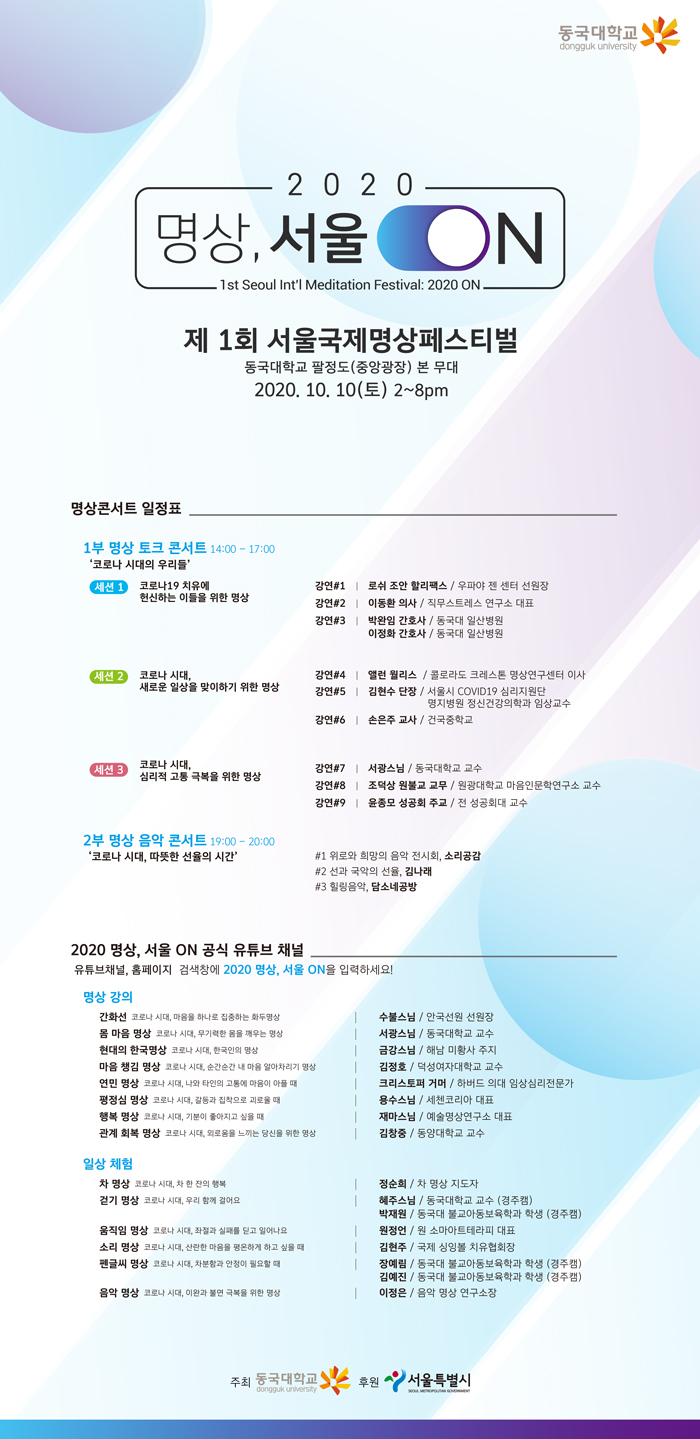
First Seoul International Meditation Festival to Be Organized by...
First Seoul International Meditation Festival to Be Organized by Dongguk University.The Main Venue for the October 10 Event is the “Paljeongdo” Plaza at the CampusDongguk University will host its first annual Seoul International Meditation Festival to overcome the COVID-19 crisis. Sponsored by the Seoul metropolitan government, the event’s theme will be “Meditation, Seoul On.” The event focuses on introducing various meditation techniques to overcome COVID-19 for those working tirelessly, such as medical staff, and those who are suffering from the disease, which would be accessible on websites such as YouTube.On October 10, the main event of the festival, “Meditation Concert,” will be held at “Paljeongdo,” the central plaza of Dongguk University in Seoul. In the first part, a meditation talk concert on the theme “Us in the Coronavirus era” will be held from 2 pm. In the second part, which begins at 7 pm, a meditation music concert titled “The Coronavirus era, the time of warm melodies” will be held.At the talk concert, Joan Halifax Roshi, head of the US-based Upaya Zen Center, Dr. Lee Dong-hwan, head of the Job Stress Institute, and Registered Nurses Park Wan-im and Lee Jung-hwa from Dongguk University’s Ilsan Hospital will introduce the practice of meditation for those who are committed to overcoming COVID-19. Dr. Alan Wallace of Crestone Mountain Zen Center in Colorado, Professor Kim Hyun-soo, head of Seoul’s COVID-19 Psychology Support Group, and Son Eun-ju, Konkuk Middle School in Busan, will deliver lectures on the topic “How to greet the new normal and meditate in the post-Corona era.” This will be followed with speeches delivered by Venerable Seo Kwang, Professor at Dongguk University, Cho Duk-sang, the head of academic affairs of Won Buddhism, and Bishop Yoon Jong-mo of the Anglican Church on the theme “Meditation to overcome the psychological pain of the Corona era.”The event will aid in alleviating the stress and frustration experienced by several people because of the pandemic through meditation lectures and demonstrations, conducted by those active in the field, including meditation practitioners from overseas and religious figures. In the second part of the meditation music concert, “Damsone Craftshop” will play healing music, and Kim Na-Rae will play meditation music based on Zen and Korean traditional tune. A musical ensemble, “Sori-Gonggam,” will play music of consolation and hope.Furthermore, the meditation lectures, which will be pre-released on YouTube, include a series of eight videos, such as the following: “The Corona era, the one-point meditation focusing the mind on one” by Venerable Subul, head of Ahnkook Zen Center, “The Corona era, the meditation of awakening the helpless body” by Venerable Seo Kwang, “When I am heartbroken from others’ and my pain” by Dr. Christopher Germer (clinical psychologist at Harvard Medical School), and “When I want to feel better” by Venerable Jae-Ma. Additionally, six meditation techniques that can be practiced in ordinary life, such as “Walking meditation” by Dongguk University students under the guidance of Venerable Hye-joo, and “Music meditation” by Lee Jeong-eun, director of the Music Meditation Institute, will be introduced.“We have designed the meditation techniques to help overcome the frustration, and we have focused on conducting non-face-to-face online programs so that anyone can easily and safely access anytime, anywhere, especially nowadays when everyone talks about feeling ‘Corona blues’ and even ‘Corona anger’,” said the chairman of the Seoul International Meditation Festival, Venerable Jong-Ho, who is also the vice president of planning. He further added, “I hope that the meditation techniques will be beneficial so that anyone can use it to cope with the difficulties.” “2020 Meditation, Seoul On” can be viewed online through the official YouTube channel of “2020 Meditation, Seoul On” or accessed in real-time through Zoom in accordance with the government’s social distancing guidelines. The details are available on the website “mind.dongguk.edu.”
2020.09.22. 조회 2118






